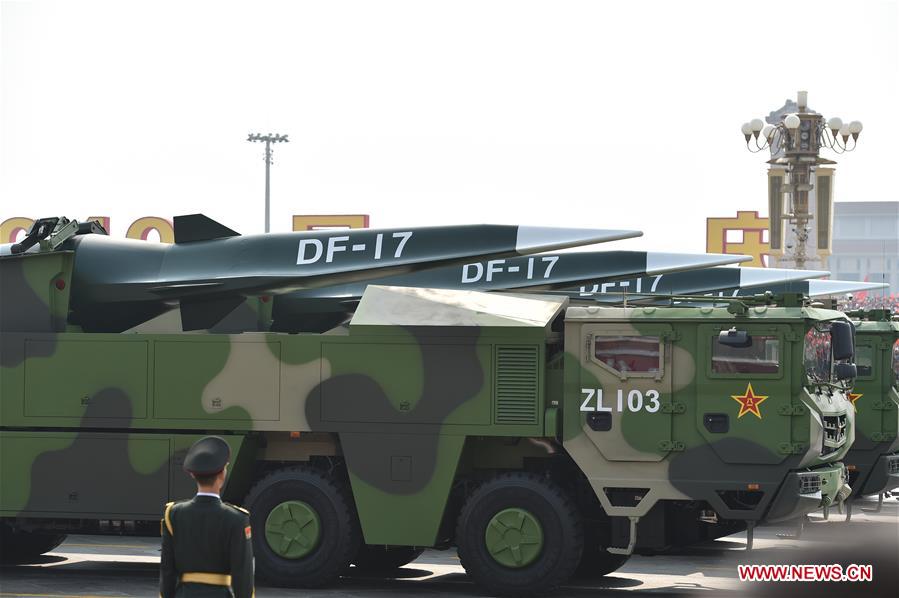The head of the US Missile Defense Agency (MDA) recently said that its Glide Phase Interceptor (GPI) program, designed to eliminate Hypersonic missiles, may not be ready even in the next decade.
Horrific Footage Of ‘Chinese Sub-Launched Missile’ Flying Near A Passenger Aircraft Gets Caught On Video
“We’re just getting started,” said Vice Adm. Jon Hill at an event hosted by the Center for Strategic and International Studies.
The MDA is working on a wide array of missile tracking sensors and defeat capabilities to build a “layered” defense against incoming ballistic and hypersonic missiles.
The GPI is one of them which is supposed to target hypersonic missiles during the glide phase of flight (once a missile has re-entered Earth’s atmosphere and is heading toward its target), which is challenging to forecast, as the missiles travel at five times the speed of sound while making rapid evasive maneuvers.
The interceptors will be integrated into the current Aegis Ballistic Missile Defense destroyers in the US Navy which would involve the interceptor being launched from its regular Vertical Launch System (VLS), connected with the Baseline 9 Aegis Weapon System that detects, tracks, controls, and engages hypersonic threats.
Terrifying Video Shows ‘Bubble-like Clouds’ After Russia Fired Its Thermobaric Bomb On Ukraine – Watch
Last year in November, the MDA-selected Northrop Grumman, Lockheed Martin, and Raytheon to design Glide Phase Interceptor (GPI). Raytheon Missiles and Defense was granted $20.97 million, Lockheed Martin $20.94 million, and Northrop Grumman $18.95 million respectively. Each vendor is supposed to provide concept designs for prototypes by September 2022.
“We’ve got three great proposals, and we may decide to stay on three, may drop to two, may drop to one. So it just really kind of depends,” said Hill.

Chinese, Russian Hypersonic Missile
In recent times, the US is increasingly becoming worried about the threat posed by hypersonic weapons from China and Russia.
In July of last year, China tested its hypersonic glide vehicle (HGV), sparking widespread concern and panic among the US military’s brass. The glide vehicle traveled around 24,800 miles (39,911 km) in space before re-entering the atmosphere and striking the ground target, according to a report by US Defense Intelligence Agency (DIA).
The DIA report reads that the flight test lasted more than 100 minutes, making it “the greatest distance flew and longest flight time of any Chinese land-attack weapons system to date.”
China is known to have a medium-range ballistic missile (MRBM), known as Dong Feng-17 (DF-17) which is capable of carrying the DF-ZF HGV. The missile itself can travel at a speed of Mach 5-10 and carry conventional or nuclear weapons. It has a range of 1,800-2,500km and a launch weight of 15,000kgs.

The DF-ZF HGV can travel at speeds between Mach 5-10 and is said to be capable of performing evasive maneuvers to tackle the enemy defenses. The DF-17 is a ground-launched missile; an air-launched version may be developed that can be deployed on the Xian H-6N bomber – the latest variant of the H-6 series bombers based on the Soviet Tupolev Tu-16 twin-engine jet bombers.
The H-6N has a range of 8,000 km and if armed with DF-17, its range can extend up to 10,000 – 11,000 km bringing the key enemy installations across the entire Indo-Pacific within its range.
A video surfaced in 2020 showing the H-6N bomber landing at an unknown airfield carrying a missile with a warhead and booster section on the bottom of its fuselage, which appeared to be similar to the DF-17 hypersonic missile.
— OedoSoldier (@OedoSoldier) October 17, 2020
Meanwhile, Russia has also developed the Avangard HGV with a range of over 6,000 km, capable of carrying both nuclear and conventional payloads. According to a TASS report, the HGV’s nuclear warhead is “more than two megatons in TNT equivalent.”
Currently, the Avangard is carried by the SS-19 “Stiletto” (UR-100NUTTH) ballistic missile but it is slated to be replaced by the R-28 Sarmat that has just been successfully tested and planned to be deployed later this year.

According to claims by Russian President Vladimir Putin, the HGV can cruise at atmospheric speeds of up to Mach 20 and it can maneuver to make its trajectory unpredictable for interception by air and missile defense systems. Plus, it can reportedly deploy countermeasures during flight to confuse the defense systems.
SM-6 Interceptor
Currently, the only counter-hypersonic capability the US has, is the SM-6 series interceptor, although the particular version of the missile is not known yet. The SM-6 can intercept the hypersonic weapon in its terminal phase – on its final approach to the target.
Considering the high speed of hypersonic weapons, the coverage of the terminal-phase SM-6 interceptor is just too low, and therefore, the MDA’s GPI program is crucial to the agency’s future work defending against hypersonic missile threats, as it would target hypersonic missiles farther away during the glide phase of flight.
Also, MDA and the Space Development Agency are currently working on the Hypersonic and Ballistic Tracking Space Sensor (HBTSS) satellites in Low Earth Orbit (LEO) that would assist the current missile warning/tracking satellites that could lose hypersonic missiles after their boost phase.
The HBTSS is supposed to be able to detect a missile launch, as well as the first, second, and third-stage separation. Once the GPI is fired by the Aegis BMD system on a Navy destroyer, it would be connected to HBTSS for updated tracking data and the interceptor would kill the threat before it got too close to its intended target.
The HBTSS is planned to be launched into orbit next year for a demonstration.
- Written by Tanmay Kadam/EurAsian Times Desk
- Contact the author at etdesk@eurasiantimes.com
- Follow EurAsian Times on Google News




